39+ ways to celebrate historic preservation during National Historic Preservation Month
May is celebrated by the National Trust for Historic Preservation as Preservation Month. This post is updated and expanded annually, to encourage us to acknowledge and celebrate historic preservation, ideally not only during Preservation Month but throughout the year, by pointing out things that we can see and do throughout the month.
The theme for 2014 is New Age of Preservation: Embark, Inspire, Engage.
From the standpoint of preservation groups, the theme is designed to encourage increased engagement by supporters, and to reach out to broader audiences, in communicating the message that preservation is essential to community vibrance, identity, and quality of place.
Right: front page of the Biloxi (Mississippi) Sun-Herald. The lead story on Monday April 28th, 2014 is focused on historic preservation.
It's also a great opportunity to try to engage local media in promoting preservation matters. Yesterday, the Washington Post ran a story ("Many of Virginia's historic sites are in jeopardy") on landmark preservation in Virginia, based on the list of Preservation Virginia's threatened buildings and sites.
Similarly, Indiana Landmarks, the statewide preservation group in Indiana, releases their list of most threatened resources just before the onset of Preservation Month, as a way to get publicity and draw attention (see "Indiana Landmarks names '10 Most Endangered' sites for 2014," Indianapolis Star, "A new pastime: Preservation Month brings plenty of events in May in Southern Indiana," Jeffersonville News and Tribune).
If you like house tours, there are many opportunities! For example, last week the New York Times ran a story ("Gawkers, Welcome: House and Garden Tours") listing upcoming house and garden tours in their primary circulation area.
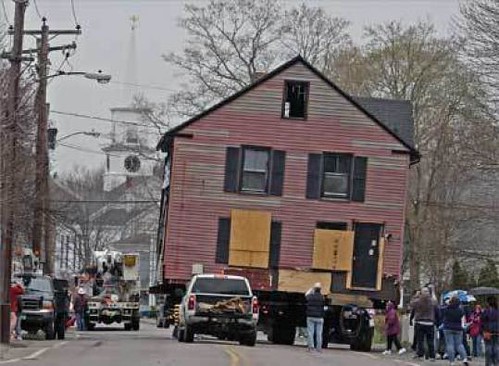
Moving a house instead of demolishing it. The Lowell Mason House, which had been scheduled for demolition, was slowly hauled to a new site in Medfield so it could be preserved. (George Rizer for The Boston Globe)
Frankly, with this long list of things you can do "during Preservation Month," you need more than one month to do everything anyway.
Things to do
1. Become a member of your citywide (or countywide or regional) preservation organization, such as the DC Preservation League, the Municipal Arts Society in New York City, Baltimore Preservation, Historic Districts Council in New York City, Cleveland Restoration Society, Preservation Resource Center of New Orleans, Landmark Society of Western New York (which serves Rochester, among other places), etc.
2. Before you get too involved, you might want to take the time to read your city, county, or state historic preservation plan. This will educate you about preservation issues in your area.
In order to implement the provisions of the National Historic Preservation Act, the National Park Service was tasked with the responsibility of working with states to create a process for designating resources for the "National Register of Historic Places." All states have historic preservation offices to coordinate efforts at the state level. And in order to be "certified" at the state and local level--this means that the agency is eligible to use federal historic preservation funds--the entity has to have a plan.
Note that something that many people find confusing is that the federal law only concerns federal undertakings--federally-owned buildings (the Post Office is exempt) and federal programs spending money locally (like aging programs or road and transit projects).
Getting national recognition from the National Register of Historic Places for a local historic district isn't enough to protect resources from local, state, or private action. Separate local and state-level laws are required.
 3. Join a neighborhood/local preservation group, such as in DC the Capitol Hill Restoration Society, Historic Takoma, or Historic Mount Pleasant).
3. Join a neighborhood/local preservation group, such as in DC the Capitol Hill Restoration Society, Historic Takoma, or Historic Mount Pleasant).4. Nationally, you can join the National Trust for Historic Preservation while you're at it. If you join, you can visit NT owned sites and affiliate organization museums at a discount/free, get discounts at Historic Hotels, and discounts on products you purchase.
5. And at the state level, most states have statewide preservation organizations. In the DC-VA-MD area, that means Preservation Maryland and Preservation Virginia/Association for the Preservation of Virginia Antiquities. Many sponsor annual or bi-annual conferences, journals, and other provide other resources.
I am always impressed by the quality of the annual conference of Colorado Preservation. (The Saving Places Conference is in February, so we missed it.)
So join your statewide group.
6. Volunteer/1. Get involved in a preservation issue in your neighborhood or the city-county at large, which could include attending meetings of your local historic district/preservation commission, which in DC is the Historic Preservation Review Board.
As one example, in the Takoma DC/Takoma Park neighborhood in DC, one of the neighborhood preservation issues is trying to get control of the Takoma Theatre, and reopening it as an arts facility.
The owner is recalcitrant and wants to either sell it for more than it is worth as a theater, or to convert it to condominiums, but in terms of strengthening the community, especially its commercial district, it would be far better to bring the building back as a theater, especially because it is one of the only remaining neighborhood theaters in the city with an intact interior. Fortunately the building is a protected resource in the DC Inventory of Historic Sites. Join the Takoma Theatre Conservancy and work with others to make the dream become reality.
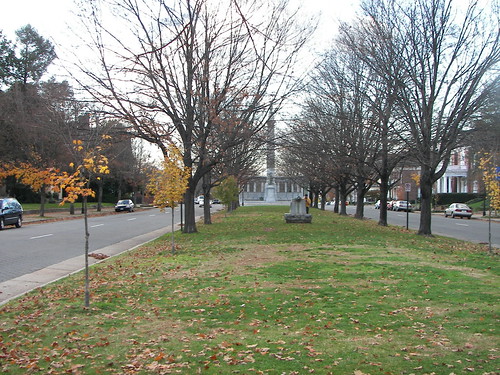
Median, Monument Avenue, with a monument in the background.
Another example is in Richmond, Virginia, where the Save our Statues organization is focused on restoring and maintain the city's statues, for example, those along Monument Avenue. See the article from the Richmond Times-Dispatch.
7. Volunteer/2, in a local commercial district revitalization initiative. A "division of the preservation movement" is the Main Street commercial district revitalization program, which links economic development with historic preservation focused on the revival of local commercial districts and downtowns in smaller communities.
There are affiliates in every state, in many provinces in Canada, and in other countries as well. In the DC region, Maryland and Virginia have state level programs--Baltimore's program at the city level is independent of the state program, and there are a number of Main Street programs in DC.
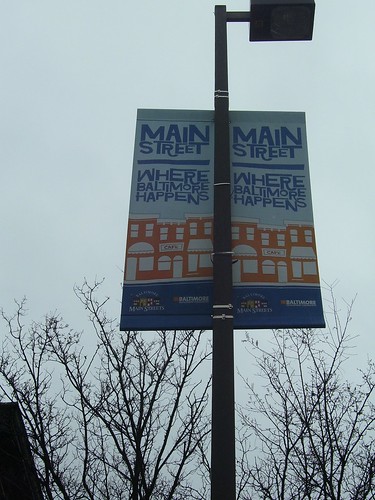
The Main Street Approach is ground up, where residents and other stakeholders join in with merchants and property owners to work on improving the commercial district overall. Typically, programs have a manager and may have additional full-time or most likely, part-time staff. It's volunteer.
Although, big downtowns and business improvement districts tend to be members of the International Downtown Association, and are more focused on clean and safe activities and tend to be run by full-time staff, although in some cities such as San Diego, many of the business improvement districts are run using the Main Street Approach.
In my experience, interestingly, volunteers in Main Street programs tend to be 10-15 years younger than those in traditional preservation organizations, and the most active Main Street volunteers tend to live closest to the commercial district.
This makes Main Street commercial district revitalization programming a tremendous opportunity to draw new demographics into the preservation movement.
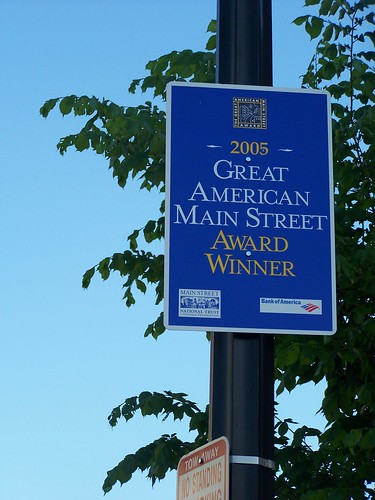
There are more than 1200 Main Street programs around the county, including active programs in every state. In 2012, H Street Main Street in DC was designated a "Great American Main Street." Barracks Row--8th Street SE--won the designation back in 2005.
The Main Street national conference will be held May 18th to the 21st in Detroit.
8. See a movie in a historic cinema building. There aren't many historic cinemas in DC proper any more, but the Uptown Theater in Cleveland Park is one. A couple years ago, we had a blast seeing a midnite film at the Byrd Theatre in the Carytown district in Richmond. And I loved how the Lincoln Theatre in DC showed "The Girl with the Dragon Tattoo" in December 2011.
-- League of Historic American Theatres
9. See a theatrical production in a "legitimate" historic theatre. You have many choices in the DC area such as the Warner, the National, the Studio Theatre, the Lincoln Theatre, the Shakespeare Theatre at the Landsburgh, the Atlas Performing Arts Center (which utilized federal historic preservation tax credits to pay for a portion of the building's rehabilitation), and sort of kind of the Tivoli Theatre in Columbia Heights.
Note that the Pittsburgh Cultural Trust and the Cleveland Theater District Development Corporation programs to revitalize their respective interest areas through rehabilitation and operation of historic theatre buildings has been vital and central to revitalization efforts in those communities. See "Playhouse Square stars in its own real estate revival" from the Cleveland Plain Dealer.
Of course, there are hundreds of such arts-based revitalization efforts, mostly on a much smaller scale, across the country.
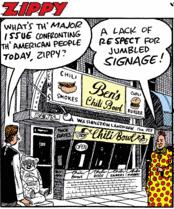 10. Shop at stores in commercial districts that are historically designated: i.e., Cleveland Park; Georgetown; Capitol Hill; Dupont Circle in DC, but there are so many across the country.
10. Shop at stores in commercial districts that are historically designated: i.e., Cleveland Park; Georgetown; Capitol Hill; Dupont Circle in DC, but there are so many across the country.11. Eat in a restaurant in a historic building/historic district. It's not that old, only 53 years, but Ben's Chili Bowl is one of the few remaining restaurants in the city that is truly old... Readers have suggested Martin's Tavern in Georgetown and Cafe Mozart, a German restaurant downtown.
12. Even if you're an atheist, it can be fun to visit a historic church building, including checking out their stained glass windows (I am a big fan of stained glass).
The Fifth Avenue Presbyterian Church in Manhattan/New York City often has its doors open when the choir is practicing. Many churches offer tours or special concerts.
If you want to learn more about church architecture, a good place to start is with the book, THE CHURCH BUILDING AS A SACRED PLACE: Beauty, Transcendence, and the Eternal.(Review of the book from the Imaginative Conservative blog.)
13. Explore an area of your city or county that you don't know. Go on a neighborhood or building tour. Check out a talk (not all of them cost money) at the National Building Museum.
14. Many preservation groups sponsor neighborhood house tours. On Sunday May 4th is the tour in Takoma (on the Maryland side). The weekend after is the house tour in Capitol Hill. There are others throughout the year in neighborhoods across the city and region.
On Saturday May 17th, the Frank Lloyd Wright Preservation Trust in Oak Park, Illinois, holds its annual House Walk tour/fundraiser.
15. Shop at a historic public food market. Eastern Market is DC's last remaining public food market building, built in 1873. (Union Market is privately owned, and was constructed in the 1970s.)
There are many great markets around the country, including the Eastern Market food district in Detroit, Reading Terminal Market in Philadelphia, the Farmers Market and Grand Central Farmers Market in Los Angeles, Pike Place Market in Seattle, the Indianapolis City Market, Lancaster Central Market in Lancaster, PA, the York Public Market in York, PA, and West Side Market in Cleveland, etc.
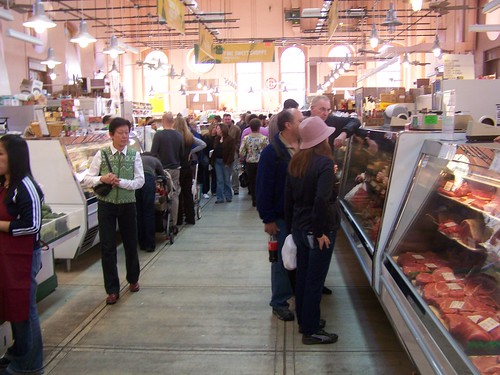
Eastern Market in Washington DC (I am a member of the EM Community Advisory Committee).
16. Check out the history resources at your local library or a specialized collection such as in DC at the Washingtoniana Collection at the Martin Luther King Central Library or the Peabody collection at the Georgetown Branch, the Kiplinger Library at the Historical Society of Washington, the Jewish Historical Society, or the Moorland-Spingarn Collection at Howard University. Many city libraries have history collections.
17. Learn about the history of your community. For example, for DC, read Dream City: Race, Power, and the Decline of Washington, D.C., 1964 -1994 and Between Justice and Beauty, and more.
In DC, the original L'Enfant Plan and follow up planning of the McMillan Commission, so that you can understand the antecedents of the city, and make better land use decisions going forward, for your neighborhood and for the city.
 Start with Washington in Maps by Iris Miller and Washington: Through Two Centuries by Joseph Passonneau. And see "Washington: Symbol and City," a permanent exhibit at the National Building Museum.
Start with Washington in Maps by Iris Miller and Washington: Through Two Centuries by Joseph Passonneau. And see "Washington: Symbol and City," a permanent exhibit at the National Building Museum.Many regional university presses publish books on local history and architecture that are well worth reading. For example, the Wayne State University Press published a fabulous book on railroad stations, Michigan's Historic Railroad Stations.
The book, by Michael Hodges, doesn't have an extensive section of introductory text, but what's there is golden--a succinct discussion of public space and the importance of railroad stations in the civic realm, and a good survey of the key texts in the field.
Johns Hopkins University Press (catalog on railroads, regional interest, including architecture) and the University of Chicago Press (architecture) both have extensive publishing programs on history and architecture, with many many excellent items. So do the MIT Press and Princeton Architecture Press.
History Press and Arcadia Publishing Company are for profit publishers with an extensive publishing program on community history.
18. Learn about why historic preservation is important, in and of itself, as well as a urban revitalization strategy. The reason I am a strong supporter of preservation is that I have come to believe that hands down, it is the only approach to economically sustainable neighborhood and commercial district revitalization that works for the long haul.
Probably the fastest way to get up to speed would be to read some of the work by Donovan Rypkema, such as his speeches, including "Culture, Historic Preservation and Economic Development in the 21st Century" and "Economic Power of Preservation," and his report on the economic value of preservation for New York, New York: Profiting through Preservation.
Note also that these reports from the University of Florida Law School's Center for Government Responsibility are also excellent: Economic Impacts of Historic Preservation in Florida, Update 2010 (Research Report: Executive Summary; Technical Report) Contributions of Historic Preservation to Quality of Life in Florida (2006) (Executive Summary; Technical Report); A Florida Boon: Historic Preservation (Research Report: Executive Summary; Research Report: Technical).
Hands down though, the best speech on the power and centrality of beauty and historic preservation in civic life is that by Mayor Joseph Riley of Charleston, SC.
19. Another way to learn a lot but very quickly is to attend a preservation conference such as the annual meeting of the National Trust for Historic Preservation (this year it's in Savannah starting November 11th), the National Main Street conference (as mentioned above, it's later this month, in Detroit), and when you visit other places, check out how they deal with historic preservation matters, and offer that learning to us when you come back.
Preservation Maryland has a good conference.
Many other areas have great preservation conferences but not in May, such as the state conference in Colorado, usually in February, and the conference of the Landmark Society of Western New York.
20. Read a historic district brochure (or more than one). In DC, they are available online or in hard copy at the Historic Preservation Office. Many communities produce and publish these kinds of publications. Two of the best I've ever read is one on Jefferson County Indiana including Madison (One of the first Main Street communities) and Hanover, and the other on the Kansas City public market, called City Market. Both lay out their respective histories chronologically but thematically.
I am a big fan of the design guidelines publications produced for cities or neighborhood historic districts, which describe local historic districts, such as those from Montgomery County Maryland, Richmond, Virginia, and Roanoke, Virginia, along with the Philadelphia Rowhouse Manual.
As are the various architecture element and style guideline bulletins published by the Capitol Hill Restoration Society.
The Roanoke Virginia Residential Pattern Book is fabulous!!!!!!!
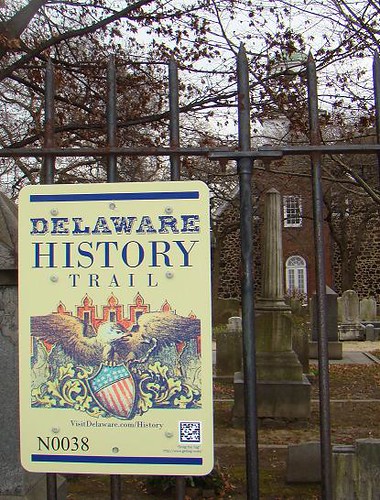 21. And follow the path of a Heritage Trail such as one of the many "produced" by CulturalTourismDC in DC.
21. And follow the path of a Heritage Trail such as one of the many "produced" by CulturalTourismDC in DC.A growing number of communities have similar kinds of interpretation programs. Richmond has introduced a trail on slavery, which obviously, given that we are celebrating the sesquicentennial of the start of the Civil War, is particularly
relevant and a good opportunity to reflect on our past,
Richmond's Liberty Trail links historic neighborhoods, sites, and attractions. (They got the idea from Boston's Freedom Trail, which more specifically focuses on sites and places significant to the American Revolution.)
Delaware has launched a state-wide history trail.
And many states and heritage areas are creating trail programs such as a whiskey trail in Kentucky, a blues trail in the Mississippi River Delta, food artisan trails, etc.
22. Take a walk or bicycle ride (or drive...) along a historic trail, road, railroad, or greenway, such as along the C&O Canal.
The C&O Canal Trust has restored some of the canal lockmaster quarters, which people can stay in. (We haven't done that yet.)
-- Great Allegheny Passage
-- National Scenic Byways Program
23. Visit a historic cemetery. In DC, we have the Congressional Cemetery or the Rock Creek Church Cemetery at St. Paul's Episcopal Church, among others.

24. Explore historic preservation matters in your region, beyond the borders of your community.
Not quite two miles from DC is the Bladensburg Waterfront Park in Bladensburg, Maryland.
Reflect about when this was a major port, when tobacco was king, and DC was still part of Prince George's County, Maryland. They offer river rides on the weekends, including a jaunt into DC to the National Arboretum.
In Prince George's County, the Historic Hyattsville (Maryland) house tour is Sunday May 18th.
Silver Spring, Maryland has a historic trail marker system too. It is being constructed over time, but a number of the markers are in place now, and the didactics on the signs are excellent. If you like Vietnamese food, one of the markers is just a couple doors down from a Vietnamese restaurant, across the street from the B&O Railroad Station, at the southeast corner of Georgia Avenue and Sligo Avenue.
Prince George's County has an extensive inventory of historic sites that are open to the public, etc.
Because 2014 is the 200th anniversary of the sacking of Washington, the Battle of Bladensburg, and the writing of the Star Spangled Banner, Maryland in particular is working up many events in commemoration. DC has just started doing some planning as well, but Maryland has been working on this for many years.
25. Check out an exhibit at a local history museum or historic site, such as at the Anacostia Community Museum or the Historical Society of Washington or one of the other house museums and historic sites in the city and region.
The Pittsburgh History Center, the New-York Historical Society, the Jamestown Experience, the Brooklyn Historical Society, the Valentine History Center in Richmond, among others, are great local museums that are definitely worth a visit.

26. Encourage your friends to stay at a historic hotel in the city or a bed and breakfast located in a historic district. For example, the Tabard Inn in the Dupont Circle Historic District is one of the most romantic places in the city to have weekend brunch--out on the patio, during the spring, summer, and fall.
Brunch at Tabard Inn, Flickr photo by lilpixiegirl03.
The National Trust for Historic Preservation has an affinity group, Historic Hotels of America, for some of these kinds of properties.
But the Standard Hotel in Los Angeles isn't a traditional historic hotel--it was an office building constructed during the art deco area for an oil company--and it's very cool!
In short, look for hotels in historic buildings, whether or not they are specifically "historic hotels." But remember, NTHP members can get discounts on rooms at HHA properties.
VRBO.com -- Vacation Rentals by Owners -- is a great site for finding places to stay in neighborhoods, including historic districts. Not only do you more directly help the local economy (typically, hotels are owned by noncity interests and most of the room rental revenue doesn't stay local), but you can--if it's your way--have a much better, more local experience. As examples, we've stayed in a house on Forsyth Park in Savannah, a rowhouse in North Beach in San Francisco, and a basement apartment in Capitol Hill in Seattle and for all intents and purposes, we got to experience those places more like locals.
27. Walk the historic grounds of a local college or university. In DC, CUA, Trinity, Georgetown, Howard, and Gallaudet have beautiful grounds and buildings. Kendall Green at Gallaudet was designed by Frederick Law Olmsted.
Note that I wish colleges would focus on this more than they sometimes do. Howard University in DC has a beautiful campus, but you'd never know as it is tucked behind Georgia Avenue with few attempts to draw people inward to the campus.
28. Visit a local railroad station, such as DC's Union Station. Designed by Daniel Burnham, it's an incredible example of the City Beautiful architectural movement. Check out chapters from Bill Wright's dissertation on Union Station. He's a great writer!
Last year was the 100th anniversary of Grand Central Station in New York City, and in Chicago, Denver, and Los Angeles new master planning and/or construction improvement projects for stations in those cities ae underway. And talk is rising for doing the same for New York City's Penn Station also. (Toronto's renovation and expansion of Union Station seems to be having difficulties according to the Toronto Star, "Mammoth Union Station project plagued by slow progress, climbing cost.")

29. Go see a museum exhibit relevant to urban history, even if it's on a seemingly broader topic. At the National Museum of American History, go see the exhibit on transportation history, "America on the Move."
Part of that exhibit uses Washington as an example specifically. But in any case, it explains the role of transportation in urban and regional development, and will give you a lot of insight into these issues as they relate to DC or any region.
30. When we travel, we like to visit house museums. For example, the Woodford Mansion in Philadelphia is really cool, and Savannah has many different house museums that you can visit, the most notorious being the Mercer-Williams House. Most cities have at least one.
31. Ride the rails. Ride Amtrak, MARC, or VRE along railroad lines in the region. The Norfolk Southern Railroad, in association with the Tennessee Valley Railroad Museum, is running steam engine passenger train excursions in various places on their system.
(Union Pacific has decided to restore a steam locomotive--it will take five years--and run similar kinds of excursions beginning in 2019, which is the 150th anniversary of the driving of the "Golden Spike" and the creation of a transcontinental railroad system. See "Big Boy steam engine to start journey to Wyoming on April 28" from the Los Angeles Times.
Both the Passaic County, New Jersey transportation plan and the heritage tourism plan (see chapter one) have elements on interpretation of historic transportation corridors (rivers, canals, rails, roads) as an element of both cultural interpretation and tourism promotion.
Don't forget National Train Day on Saturday May 10th. There will be many events in dozens of cities across the county.
And of course, there are many special scenic railroad organizations, Rail and Transit museums (e.g., the B&O Railroad Museum in Baltimore, the Baltimore Streetcar Museum and the National Capital Trolley Museum in Montgomery County, Maryland), and ride opportunities too.
-- Tourist Railway Association
32. So try to ride a historic streetcar as well.
San Francisco's F Line (the Market Street Railway) is run with historic streetcars painted in the liveries of various different historic streetcar operations from the US and Europe. Membership in the group entitles you to their quarterly newsletter, which is fabulous.
And everyone knows about the streetcars in New Orleans. But streetcars run in places like Toronto, Philadelphia, Tampa, and Boston too. Not to mention new streetcars such as in Portland, Tacoma, Seattle, etc. Memphis re-created part of its historic trolley system, which runs Downtown and in the riverfront district, in 1993.
33. Visit a national (or state) park. DC, for obvious reasons, has many nationally owned parks, the system of Fort Circle Parks works to preserve the forts built during the Civil War to protect the city from Confederate invasion. Fort Stevens, hidden behind a church on Georgia Avenue, around Quackenbos Street NW, was attacked by Confederate forces, and President Lincoln was up there and watched. Up Georgia Avenue a bit, close to Walter Reed Hospital, is a somewhat forlorn and neglected battlefield cemetery and monument honoring soldiers who died at the battle at Fort Stevens.
-- National Park Service, find a park
-- list of state and national heritage areas, Alliance of National Heritage Areas
-- America's State Parks
34. Check out a historic school building and work to preserve historic schools. The DC Public School system has an archives and museum that is also a meeting center, Sumner School, at 17th and M Streets NW.
And work to ensure that historic school buildings are preserved in your community. Sprawl-supportive building accreditation standards for school buildings push the concept of larger campuses served by school buses.
-- Historic School Preservation help page, NTHP
-- Why Johnny Can't Walk to School: Historic Neighborhood Schools in the Age of Sprawl, NTHP
-- Helping Johnny Walk to School: Policy Recommendations for Removing Barriers to Community-Centered Schools, NTHP

35. Check out a historic library building. A number of DC's libraries were built with support from the Carnegie Foundation (Northeast, Southeast, the old Carnegie Library downtown, Takoma, and Mount Pleasant, which is particularly gorgeous). Visit one.
36. Take a boat trip on a local river. The pontoon boat tours of the Anacostia River leaving from the Bladensburg Waterfront Park (in Prince George's County) dip into DC. From their website:
Free interpretive pontoon boat tours take place from April through October.
37. If you own "an old house," and want to learn more about historically sympathetic renovation, I highly recommend subscribing to magazines such as Old House Journal, Old House Interiors, American Bungalow, This Old House, etc.
You learn about historic architecture and details. They run features on interesting neighborhoods, places you can try to see when you travel. And the magazines offer good ideas of how to make historically appropriate changes in your own house.
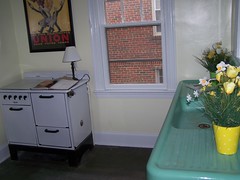
I hadn't been interested much in "the decorative arts" and interiors of houses all that much before, but having moved into a 1929 bungalow that was relatively intact, and including a 1930s Magic Chef Oven (photo, left), I've become much more attuned and interested.
But it's also important to acknowledge the preservation movement for houses (and buildings) of the recent past. Publications focusing on that era include Modernism, Atomic Ranch, and Midcentury Magazine from the UK.
38. Check out a monument or memorial in your community and learn more about it. We can't preserve what we don't understand or appreciate.
39. If you have children in your life, how about doing an activity with them that is preservation related?
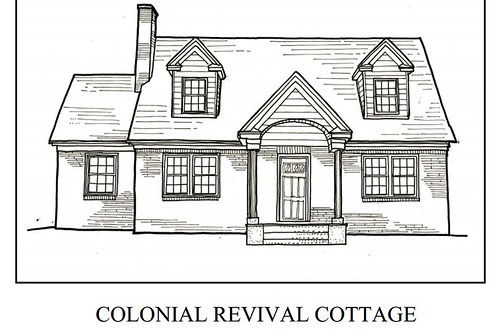 Many preservation organizations have produced coloring pages or books for children as well as offer educational activities.
Many preservation organizations have produced coloring pages or books for children as well as offer educational activities.The Architectural Styles Coloring Book from Roanoke is very good. Perhaps there are similar kinds of houses in your community and you could do a field trip to houses with similar styles, and then the child could color the pages.
-- Architecture for Young Children webpage, Pittsburgh History and Landmarks Foundation
40. What suggestions do you have?
Labels: civic engagement, cultural heritage/tourism, historic preservation, neighborhood planning, urban design/placemaking








1 Comments:
Much thanks to you for giving such significant data, and a debt of gratitude is for sharing this Business Promotion system.
Post a Comment
<< Home